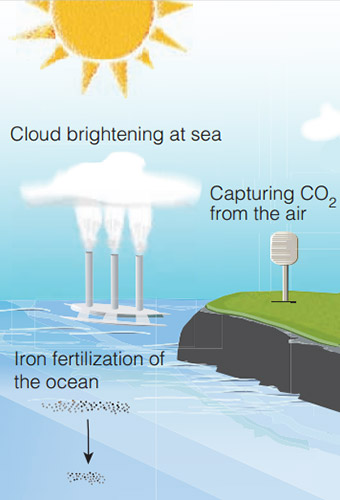Can Engineering Change Our Climate for the Better? Part 1
Can Engineering Change Our Climate for the Better? Part 1


Climate engineering is the process of designing large-scale systems that have the potential to control climate and reduce the impact of climate change. This is a highly controversial topic because of the complexity of the systems involved and the possible negative effects upon the environment and human populations.
The field of climate engineering is in its relative infancy. New climate engineering techniques are likely to materialize the more we learn. Prof. Deborah Gordon, Carnegie Mellon University
Climate change technologies are largely theoretical at this stage and fall into two main categories: greenhouse gas removal and solar radiation management. So far these methods have been developed and tested via laboratory studies and simulations, with only a few small-scale prototypes tested in the field. No technologies have yet been deployed at a large-enough scale to have global impacts. But they are worth watching as the public and private sectors seek new solutions for specific applications.
Greenhouse Gas Removal
Greenhouse gas removal strategies focus on removing greenhouse gasesfrom the atmosphere, especially CO2. Humans have increased atmospheric CO2concentration by more than a third since the Industrial Revolution began, according to NASA, which calls CO2 “the most important long-lived ‘forcing’ of climate change.” The top greenhouse gas removal strategies include:
- Bioenergy with Carbon Capture and Storage (BECCS). This approach takes advantage of carbon naturally stored by plants during photosynthesis. “By burning biomass to generate energy before it decomposes and releases its bounty of carbon and then capturing the carbon released during biomass combustion and storing it underground, BECCS removes carbon dioxide from the atmosphere,” says Deborah Gordon, the director of the Energy and Climate Program at Carnegie Mellon University. An active BECCS project is the Archer Daniels Midland project in Illinois, which captures carbon and uses it to enhance oil recovery in nearby wells. The project removes more than 1 million tons of carbon dioxide from the atmosphere annually.
- Biological Carbon Sequestration. These technologies engineer biological building blocks of plants and other systems to take in more CO2, thereby reducing levels in the atmosphere. “Experiments are under way to create plants with an increased appetite for carbon dioxide,” Gordon says. Researchers at Max Planck Institute in Germany are attempting to use enzymes to alter the biochemistry of photosynthesis—for example, creating algae that is specially designed to pull CO2 out of the atmosphere.
- Direct Air Capture. These technologies capture industrial-scale quantities of carbon dioxide from the air in the atmosphere. Several approaches are being tested, including designing mechanical trees that absorb carbon dioxide. Klaus Lackner, director of the Center for Negative Carbon Emissions at Arizona State University, invented a version of the mechanical trees while he was a professor at the Columbia University Earth Institute. He covered the structure with artificial leaves made from a resin that absorbs CO2. “As the windblows, these ‘leaves’ take CO2 out of the air,” he says. “When the tree is dry, it loads and when it is wet, it releases CO2 back. We then pump it out of the chamber and compress it to liquid CO2.”
Other methods include running air through a caustic chemical process to remove carbon dioxide,geochemical techniques where CO2 reacts with certain minerals to create geologically stable carbonates. Another, “air-capture plants,” uses walls of fans to strip carbon dioxide from the atmosphere.
Read Part 2 to discover more about of environmental engineering.
Mark Crawford is an independent writer.





